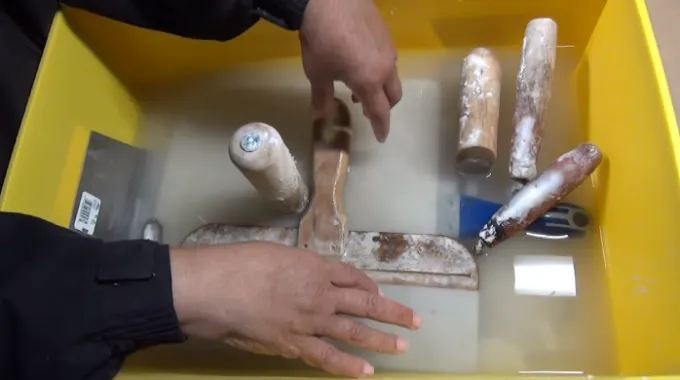Last Updated on March 5, 2023
With some caveats, cleaning your drywall tools in the sink is possible. While it may be tempting to toss your tools into the sink and call it a day, this isn’t a great idea. For one thing, drywall dust can clog up pipes if left unchecked, leading to all sorts of plumbing issues down the line.
Fortunately, you can take a few steps to ensure that your tools stay clean without causing any plumbing headaches or lasting damage.
To clean drywall tools in the sink, the tools should be scraped or brushed to remove as much joint compound as possible, cleaned with water, and rinsed thoroughly to ensure all remaining compound is removed, then washed and dried before storage.
We will detail the specific methods and techniques for properly cleaning drywall tools in the sink. We will also discuss common mistakes to avoid and tips for maintaining your tools in top condition.
How Can You Clean Drywall Tools Avoiding Sink: 3 Methods

Gather Necessary Materials
Water
Water is essential for cleaning most surfaces, including drywall tools. To gather the necessary amount of water, you can use either a bucket or a sink. Cleaning in the sink requires running the tap until enough water is collected to submerge the tools completely.
The water should be relatively warm, although not hot, as too much heat could damage the tools or cause them to warp. Adding some mild detergent will help break down any dirt and debris on the tools.
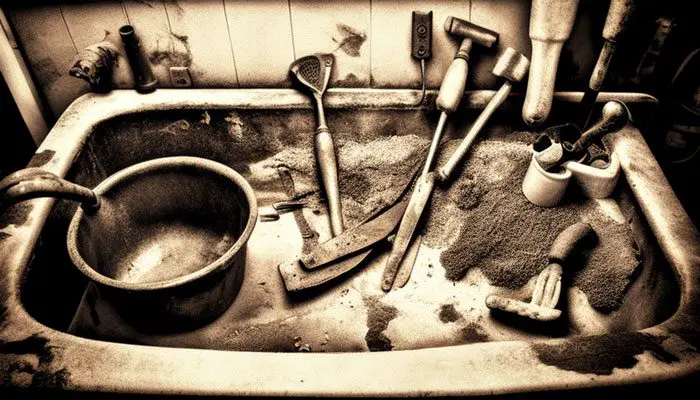
Mild Detergent
A mild detergent is key when it comes to a thorough cleansing of the drywall tools in the sink. Opt for a gentle formula that won’t leave behind chemical residue, as this can affect their performance during use.
Mixing half a capful into a gallon of warm water before immersing your drywall tools should do the trick without damaging them in any way. Make sure to rinse everything thoroughly with clean water before drying off your items and storing them away safely afterward.
Scrub Brush or Sponge
Lastly, gather a scrub brush or sponge if needed for any stubborn dirt and grime on your drywall tools that cannot be removed just by submerging them in the water and detergent mix.
Choose a sponge or brush with soft bristles that will not leave scratches on your tools but still can get deep down into all the nooks and crannies where dirt may be hiding away.
Once you have all your materials gathered together, proceed with cleaning the drywall tools in accordance with their instructions (if available).
Rinse Drywall Tools in the Sink Under Running Water
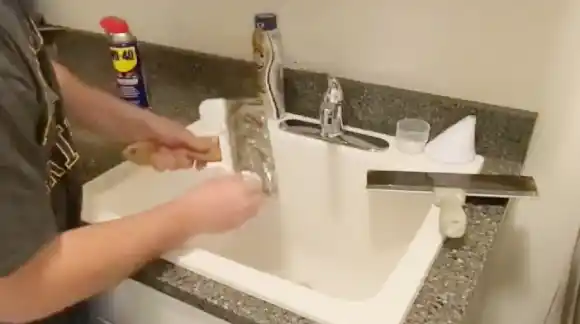
Why is it Important to Rinse Tools Before Scrubbing?
It is essential to rinse drywall tools before scrubbing because it removes any sawdust or dirt that may have accumulated over the surface of the tool. This ensures that the tool is clean and in safe working condition.
Rinsing drywall tools in the sink beneath running water is a good way to ensure that all debris has been removed from these tools. To do this, you should insert their drywall tool into a sink and run warm or cold water over it for several minutes.
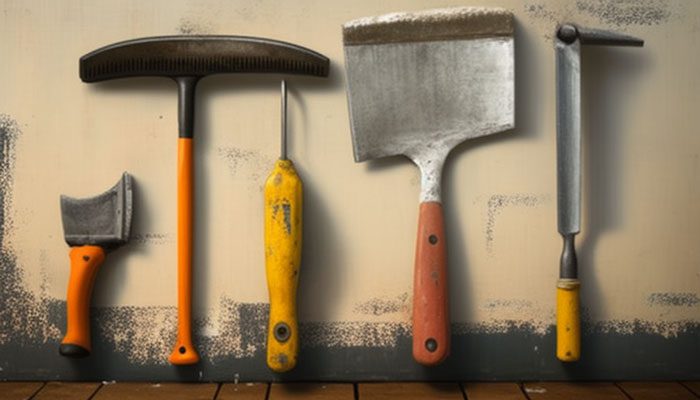
If necessary, you can use a soft brush or cloth to help remove any existing dirt or buildup. You should periodically open and close their tool while it is under running water to ensure all areas are being rinsed off properly.
After rinsing the tool, you should take care to thoroughly dry it with a clean cloth before moving on to the next step of scrubbing the drywall tool.
How to Properly Rinse Drywall Tools Before Scrubbing?
Rinsing your tools for drywall in the sink under water ensures that these tools are clean and safe for use. To do this properly, you should fill up their sink with either warm or cold water and then submerge their drywall tool into this water.
You will then need to keep the tool submerged while running cold or warm water over it for a few minutes to ensure adequate cleaning. You should also periodically open and close the drywall tool while it is submerged to ensure that all parts of the surface are properly rinsed off with fresh running water.
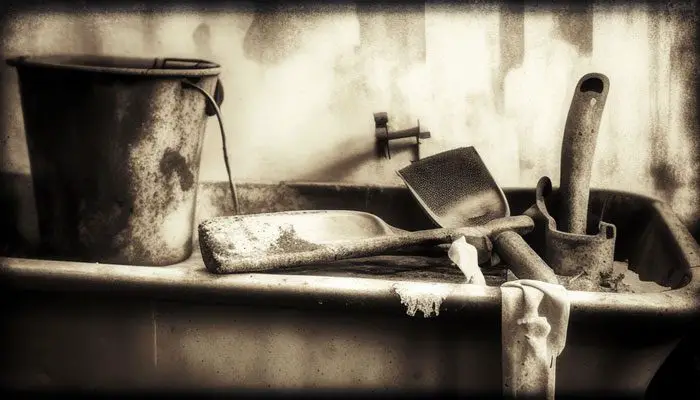
After this step is completed, you should take extra care to make sure that you have dried off all excess moisture from their drywall tools before moving on to scrubbing them further.
Apply and Scrub Drywall Tools with Mild Detergent
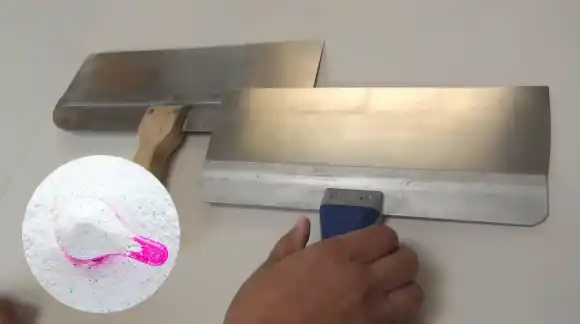
How to Properly Apply Detergent to a Scrub Brush or Sponge?
When applying detergent to sponges or scrub brushes, it is important to use a mild detergent so as not to damage surfaces. Apply the detergent directly onto the bristles of the scrub brush or onto the surface of the sponge.
It is best to avoid pouring the detergent onto a hard surface such as a countertop and instead put it directly on the tool that will be used for cleaning.
Gently massage the detergent into the bristles or surface of the sponge until it has been distributed evenly. Once this has been done, it can then be used to clean whatever surface needs to be cleaned.
How to Properly and Effectively Scrub Drywall Tools?
For effective and proper scrubbing of drywall tools such as trowels and flat blades, start by using a mild detergent solution on them first. Make sure to apply an even coating of the solution across all surfaces that need to be cleaned.
Use a soft-bristled scrub brush or microfiber cloth to gently work the soap into the tool’s crevices and corners.
A microfiber cloth or bristled scrub brush will help remove any stubborn dirt and grime more effectively than just wiping it down with soap and water alone. After rinsing off any residual soap solution, dry off the tools with a lint-free cloth for best results.
Rinse Drywall Tools Thoroughly Under Running Water
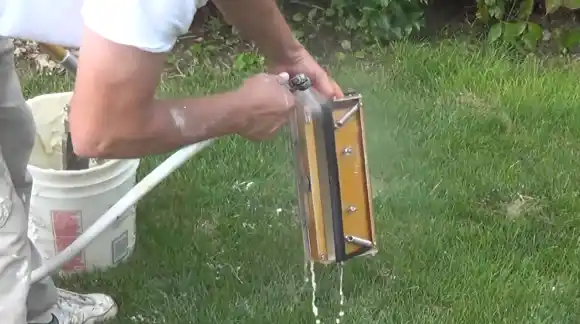
Importance of Removing all Traces of Detergent
It is essential to remove all traces of detergent when cleaning drywall tools after a job. This ensures that no residue is left on the tools, which could cause problems during future use.
To properly rinse drywall tools, scrub the tools with mild detergent and warm water. Use a soft-bristled brush to ensure all dirt and grime are removed. After scrubbing thoroughly, rinse with hot running water to ensure that all traces of detergent are gone.
Make sure to inspect the tools afterward for any leftover residue that the brush or water may have missed. If present, use a microfiber cloth to wipe away any residual detergent before storing the tools away.
How to Adequately Rinse Drywall Tools After Scrubbing?
Rinsing drywall tools thoroughly in your sink under running water after scrubbing them with detergent is critical in ensuring that no residues remain on the surface of the drywall tool afterward.
To properly do this, start by scrubbing off dirt and grime from the surfaces; this can be done using a mild detergent and warm water, as well as a soft-bristled brush. Once dirt and grime have been removed, it is time to rinse off the tool using hot running water.
Ensure that all areas of the tool have been rinsed carefully until suds disappear from its surfaces; if there are any remaining suds or residues visible on the tool after rinsing, then it should be wiped down with a clean microfiber cloth until they are gone.
Finally, once all residual detergents have been removed from the surfaces of your drywall tools, it is safe to store away for future use.
Dry Drywall Tools Completely Before Storing or Using them Again
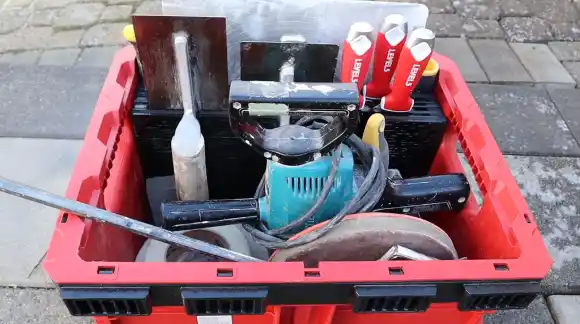
Importance of Drying Drywall Tools Completely
It is important to dry drywall tools completely prior to storing or handling them again to prevent the growth of mold and other contaminants. If tools are left wet, the metal components can corrode, shortening their lifespan, and the wood components will be more likely to warp and crack due to exposure to moisture.
This can lead to a decrease in efficiency when using the tool. If tools are improperly stored while wet, they can become stained or discolored due to residue that may build up on them.
Take the time to completely dry all tools before storing them, as it is essential for maintaining their condition and ensuring they last as long as possible.
Methods for Drying Drywall Tools
To ensure that drywall tools are entirely dry before they are stored or used again, there are several methods that can be used in a step-by-step guide.
- The first step is to thoroughly wipe down the surface of the tool with a clean rag. This will help get rid of any residual moisture that might still remain on the tool after use.
- The second step is to air dry the tool outdoors for several hours in direct sunlight. This will allow for any remaining moisture on the tool to evaporate and ensure complete drying of the tool’s surface.
- The third step is to take a hairdryer and gently heat up the tool’s surface for a few minutes until it feels completely dry when touched by hand.
- Finally, if necessary, let the tool sit out overnight indoors so that any remaining moisture has time to slowly evaporate off its surface into the air and not onto other items around it in storage.
Following these steps will ensure that your drywall tools are completely dry before you store or use them again.
Can You Wash Drywall Spackles Off Your Tools in the Sink?
Spackles and other drywall tools should not be washed in the sink. If drywall mud is washed down the drain, it can clog drains and pipes, resulting in costly plumbing repairs. Mud residue left behind may damage fixtures and other sink areas.
Any tools containing drywall mud should be cleaned outside or in a bucket and the water discarded outside. It prevents any potential clogging issues as well as leaving no tracks of mud behind. Washing drywall spackles in the sink will cause a mess or damage.
Use gloves and goggles when cleaning off anything with drywall mud for safety reasons. Upon contact with drywall compounds, skin irritation can occur, and when disturbed, carcinogens can be released, posing serious health risks. Industrial-grade gypsum (drywall) must be handled with appropriate safety precautions.
How Do You Keep Your Drywall Tools from Rusting?
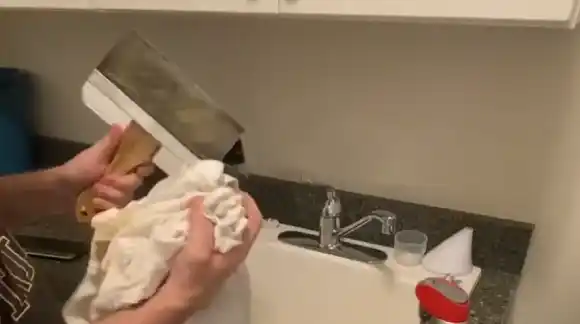
To save your drywall tools from getting rusty, it’s important to store the drywall tools properly when not in use. Ensure your drywall tools are clean and free of any excess moisture or dust particles before storing them.
It’s also beneficial to lightly coat the drywall tools in oil such as WD-40 or mineral oil this will help protect against moisture damage and oxidation that could cause rusting over time.
Check your tools regularly for signs of rusting or corrosion so that you can take action immediately if needed, wipe down with a cloth soaked in vinegar or lemon juice to help remove any rust spots that may have formed.
Finally, store them in a cool, dry place away from direct sunlight or sources of moisture for optimal protection against oxidation and rusting.
How Do You Clean Muddy Drywall Tools?
To clean muddy drywall tools after use, start by wiping off excess dirt with a damp rag before hosing your drywall tools down with water outside.
Then fill up a bucket with hot water mixed with laundry detergent and submerge your tools into it let soak for at least five minutes before scrubbing them down with an old toothbrush or steel wool pad. This should break up tough clumps of mud without damaging the surfaces of your equipment.
Once finished cleaning, rinse thoroughly with cold water until all soap residue is gone. Allow the drywall tools to air-dry before storing them in a cool area out of direct sunlight for optimal preservation against corrosion and rusting.
Final Thoughts
Cleaning your drywall tools is an important part of maintaining their condition and functions. While it may seem like a tedious job at first glance, it doesn’t have to be complicated or time-consuming.
By following our simple steps for cleaning drywall tools in the sink with water and mild detergent, you can keep your tools looking brand new. Be sure to rinse all traces of detergent from the blades after scrubbing as well as completely dry them before storage or use again.
You should also consider washing off spackles from the blades as much as possible when cleaning them in order to prevent any damage or rusting issues down the line. With these tips in mind, keeping your drywall tools looking great shouldn’t be an issue at all.
